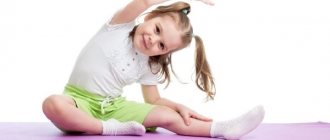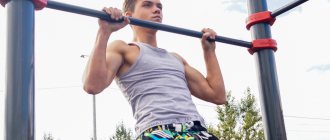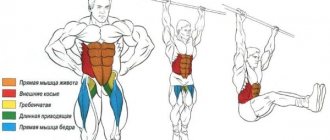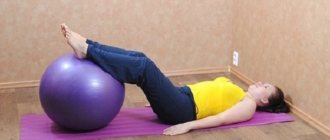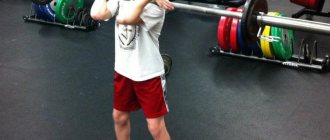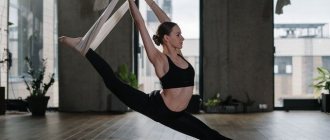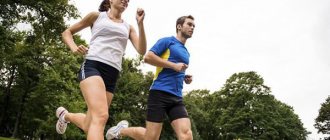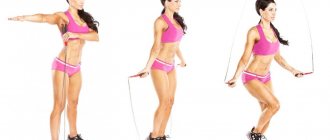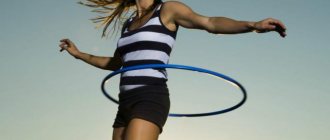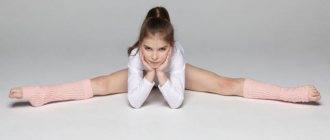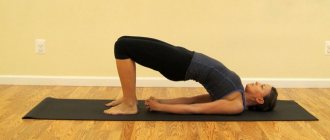History of the origin and development of artistic gymnastics
Independent gymnastic elements arose long before our era. e. In ancient China, great attention was paid to developing balance and stretching. In Ancient Greece, gymnastics was called physical culture. Homer and Plato, despite the fact that they were opponents in philosophical matters, agreed on the opinion that doing gymnastics is useful for both physical and mental health. Among the Greeks, the varieties of gymnastics as physical culture were wrestling, athletics, horseback riding, running, swimming, etc.
Gymnastics has a long history. Considering that today the concept of a “healthy lifestyle” is becoming more and more urgent, and the state is developing many programs to develop sports “for everyone,” gymnastics has a great future and broad prospects.
Gymnastics in antiquity and the Middle Ages
Gymnastics especially flourished among the Greeks. There were special buildings for classes – gymnasiums. The term "gymnastics" appeared during the heyday of Hellenic culture in the 8th century BC. Among the Romans, such a sport existed only for the needs of military service. Even a separate craft of athletes and gladiators arose. The Romans used acrobatic exercises, which at that time reached a high technical level thanks to traveling acrobats who were popular among the people.
In the process of transition to a new economic formation, feudalism, gymnastics was forgotten. The ideal of man has changed. Under the influence of theology, physical exercise classes were canceled in all educational institutions, and children's games, distracting from reflection, were called the source of sin.
During the Renaissance, physical education systems began to be created in all major cities. Figures of that time called gymnastics an excellent means for strengthening health, spirit and harmonious development of a person. The time of formation of the first elements of sports gymnastics in Europe can be considered the 16th-17th centuries. Types of gymnastics were popular: acrobatic exercises, complex jumps, rope climbing, etc.
The origin and development of modern artistic gymnastics
Germany became the birthplace of modern sports gymnastics. In the late 18th and early 19th centuries, German educator Friedrich Ludwig Jahn founded Europe's first gymnastics society and founded the first gymnastics school. In England, gymnastics was neglected. Physical development was achieved by rowing, horse riding, and running. Sweden, France and the Czech Republic became followers of Germany. In Swedish gymnastics, a place was given to floor exercises and competitions. Since the mid-19th century, gymnastics has become a generally recognized sport not only in Europe, but also in America.
At the end of the 19th century, international sports federations began to be created. Not only sports gymnastics was the object of their attention, but also the development of “sport for everyone”. Olympic sports types of gymnastics include the following disciplines:
- men's and women's sports gymnastics;
- trampolining;
- gymnastics.
Non-Olympic sports include:
- sports aerobics;
- jumping on an acrobatic track;
- sports acrobatics.
The variety of gymnastic exercises and the accumulated experience of their use to solve various pedagogical problems served as the basis for identifying relatively independent varieties of gymnastics:
- basic (for schoolchildren and students);
- professional-applied (professional, military, sports orientation);
- athletic (strength);
- health (household and industrial forms);
- therapeutic (corrective and restorative).
Now gymnastics is being transformed into new varieties:
- dance;
- men's art;
- family;
- harmonic;
- aesthetic;
- cheerleading, etc.
The emergence of new types of gymnastics is associated with the synthesis of exercises. Based on sports varieties of gymnastics, its new types are focused not only on sporting achievements, but also on the opportunity for gymnasts to participate in holidays, festivals, and demonstration performances.
Why gymnastics is useful
Today there is no person who would ask the question why gymnastics is needed. Let us list several beneficial properties of gymnastics:
- Speeds up metabolism and prevents ARVI. Moderate exercise improves immunity, helps the body fight colds and lose extra pounds.
- Increases performance and leads to success. Gymnastics is a charge of vital energy. It helps you work more productively, think better, and cope with stress.
- Reduces fatigue. Regular exercise stimulates the production of serotonin and dopamine, which prevent you from feeling tired.
- Is a natural pain reliever. Exercise promotes the production of happy hormones, which are a natural pain reliever.
- Increases sexuality. Gymnastics can put a woman in a sexual mood due to the fact that blood supply to the whole body improves.
- Improves heart function. By pumping blood into the muscles, the heart also trains, the walls of blood vessels are strengthened, and blood pressure is normalized.
- Removes toxins from the body. The blood supply to the skin and internal organs increases, the lymphatic system gets rid of harmful accumulations. Increased breathing and sweating help detoxify the body.
- Helps you find new friends. A person joins a community of like-minded people for whom natural movement is the norm. You can share your achievements with others in order to grow and develop, find new like-minded people and new interests.
- Relieves depression. Gymnastics has a positive effect on processes in the brain; physical activity improves mood. In response to physical activity, the brain begins to produce substances that are antidepressants.
- Provides healthy sleep. Moderate exercise will not interrupt sleep, and people who lead a sedentary lifestyle suffer from insomnia.
To benefit from gymnastics to the fullest extent, you need to finish complex classes with relaxing and stretching exercises. After training, it is necessary to restore the heart rate indicators inherent in age and certainly engage in wiping or proceed to water procedures.
The rules of artistic gymnastics in brief
Among men and women, the winner is determined on individual apparatus both in the team competition and in the overall championship. The rules of artistic gymnastics stipulate that athletes are given one attempt to perform one exercise, except for the vault for women.
Each of the athletes himself determines the performance program, taking into account the requirements for each type of exercise and its complexity.
Competitions are held on 7 apparatus. Performances may include combinations of somersaults, somersaults, splits, stand-ups, and the like.
The judges evaluate not only the complexity of the program, but also its individual elements, confidence and cleanliness of execution. It is important not to forget about artistry and composition.
Performance time is limited:
- men – 1 minute 10 seconds;
- women – 1.5 minutes.
After the judges' assessment, the one who scores the most points becomes the winner.
Rules of judging in artistic gymnastics
Performances at competitions are assessed by the chief judge and eight judges, each responsible for his own apparatus.
The judges are divided into 2 groups. Two evaluate the complexity of gymnastics elements and composition, and six others evaluate the execution technique. The assessment is made using a 10-point system. Points are deducted from the score given by the first group of judges:
- 0.1 points for a small error;
- up to 0.4 points for a gross error;
- 0.5 points for falling from the projectile;
- 0.4 points (for assistant insurance).
The rules provide for a reduction in marks for stepping on the carpet and failure to comply with the limit.
The overall score is assigned by a panel of judges assessing the difficulty of the presented program. Each judge evaluates the technique individually. The best and worst are not taken into account, and the average result is taken from the remaining four.
The team competition uses a 6-5-4 scheme. No more than 6 athletes compete for each team, 5 of them work on the apparatus. The 4 best results are taken into account.
In team competitions during the individual championship, the athlete is given 1 attempt to perform a gymnastic movement on a particular apparatus.
Olympic Competition Regulations
At the Olympic Games, artistic gymnastics competitions are held in two stages: qualifications and finals.
Qualifying round
Qualification is carried out within one day. In Tokyo, the men's qualification was held on July 24, the women's on July 25.
At the qualification stage, finalists are selected for all artistic gymnastics disciplines. Each athlete practices his own apparatus. A gymnast participating in the all-around performs exercises on all apparatus.
Final competition
The final part is divided into several days. Two days after the qualification, the team all-around final is held. In two more days - the final of the individual all-around. In a few days, Olympic medals will be competed for in the remaining disciplines of artistic gymnastics: floor exercise, apparatus, vault.
The composition and number of finalists are determined based on the results of qualification. The following qualify for the final part of the competition: 8 gymnasts - on each gymnastic apparatus (no more than two athletes from the same country); 8 teams – to participate in the team all-around; 24 athletes – to participate in the individual all-around (no more than two from one country).
Restrictions
In artistic gymnastics, an unpleasant rule for athletes has been established - “the third wheel”. It limits the number of athletes from the same country in individual competitions. Let me give you an example.
Women's qualifying competitions took place at the Tokyo Olympics. European champion in the individual all-around, Russian gymnast Victoria Listunova, took sixth place in the individual all-around at the qualifying stage. It would seem that Victoria has every chance to compete for an Olympic medal. But Listunova did not qualify for the final part of the individual all-around competition. The fact is that two more Russian gymnasts are in fourth and fifth positions: Angelina Melnikova and Vladislava Urazova.
A similar situation arose in the women's uneven bars qualifying round. Four Russian gymnasts entered the top eight at once. But only 2 Russians made it through the final part of the competition.
Competition program and gymnastics apparatus
Gymnastics is the technical basis of many sports; corresponding exercises are included in the training program for representatives of a wide variety of sports disciplines. Competitions are held in the following sports:
- all-around;
- floor exercise;
- horse;
- rings;
- vault;
- parallel bars;
- crossbar;
- uneven bars;
- log.
The competition program consists of compulsory and voluntary exercises.
According to the nature of the competition, they are divided into:
- personal (personal results are counted);
- team (team results are counted);
- personal-team (personal + team).
Lesson program:
- On the uneven bars.
- Floor exercise combination.
- Vault.
- On a balance beam (female).
- On horseback (male).
- On the rings (male).
- On the crossbar (male).
It is better to do gymnastics from 4-5 years old. The sooner you start, the easier it will be to master difficult exercises.
Basic classification and types of gymnastics
Gymnastics is more of a collective concept. Types of gymnastics in accordance with the main classification: recreational, sports, applied.
Acrobatic gymnastics
Acrobatic gymnastics is a non-Olympic sport. It involves performing a set of exercises while maintaining balance and rotation of the body with or without support. The basis of gymnastic exercises is mastery of the body and good muscle development.
The complex is performed to music on an elastic gymnastics mat. The exercises begin with a static position, continue with a choreographic composition and end with a static position.
Exercises are divided into:
- balance – demonstrates strength, agility, flexibility, balance;
- dynamic (tempo) - demonstrate flight with throwing, pushing, catching;
- combined (mixed) – contains elements of balance and dynamic exercises.
Judges evaluate:
- complexity of the composition;
- artistry;
- performance technique.
Acrobatic gymnastics is included in the family of different types that are part of the International Gymnastics Federation.
Athletic gymnastics
This is a system of physical exercises, including with a barbell, dumbbells, kettlebells, and various block devices, aimed at the harmonious development of muscles. Exercises for muscle development were combined into training complexes that act evenly and deeply on all muscle groups.
Athletic gymnastics comprehensively develops a person and contributes to success in other sports. This type of exercise is widely popular among young people. Men and women of all ages and any level of physical fitness can practice. The only condition is the absence of diseases of the cardiovascular system.
Classes develop:
- strength;
- endurance;
- muscle reaction speed;
- flexibility;
- agility and coordination.
Gymnastics without equipment is a preparation for working with weights.
General developmental gymnastics
This type of gymnastics trains endurance less than others, but is capable of developing muscle strength, strengthening joints and maintaining their flexibility. When performing exercises, the articular surfaces of the bones slide relative to each other and, as a result, strengthen the joints. During movements, moderate irritation of the cartilage layers covering the joint occurs, which contributes to their thickening and improved nutrition.
An increase in cartilage mass increases the shock-absorbing properties of cartilage and reduces the load on bone articular surfaces, preventing their damage and salt deposition.
A variety of types of gymnastic exercises, a large arsenal of forms of movement allows you to specifically influence individual muscle groups, joints, makes it possible to correct defects in posture, and treat post-traumatic injuries to muscles and joints. Developmental gymnastics includes exercises that can be performed using sticks, hoops, and elastic rubber bands, which enhance the effect of the exercises. The most common form was morning exercises, which received a short and precise name - exercises.
Wellness
It is a full range of physical exercises that help improve well-being. It includes fairly easy to perform movements. Health-improving gymnastics is much more convenient and enjoyable than fitness. Health-improving gymnastics exercises can be carried out as short-term exercises of up to 20 minutes.
Physical education sessions, industrial gymnastics – types of health-improving gymnastics. There are many methods; Chinese health-improving gymnastics, which has several directions and solves problems depending on the direction, is especially popular. Health-improving gymnastics is important and necessary for the human body. By doing it regularly, a person prolongs youth, maintains health and longevity.
Aerobics sports
Sports aerobics is a sport in which a continuous and highly intense set of exercises is performed, including combinations of acyclic movements with complex coordination, elements of different structural groups of varying complexity and interactions between partners (in programs of mixed pairs, triples, groups).
Gymnastics such as sports aerobics is a complex and emotional type of sport in which a set of exercises with high intensity and complexly coordinated elements is performed to music. Elements from sports and rhythmic gymnastics and acrobatics are used here. Much attention is paid to choreography in the programs of mixed pairs, triples and groups, and interaction between partners.
The entire content of sports aerobics is formed on the basis of seven basic movements of health-improving aerobics, which are performed against the background of jumping, running, and marching in a mixed mode. Such a system of cyclic actions, combined into a composition, performed at a high tempo to music (2.5 movements per second), carries an emotional charge and is visually perceived as a virtuosic motor action.
Applied gymnastics
Exercises of applied types of gymnastics solve special problems related to the development of physical and volitional qualities necessary for professional purposes, as well as therapeutic ones. Professional applied gymnastics promotes the development of special motor skills, on which the success of professional activity depends. Such training is necessary for a high-altitude installer.
Military applied gymnastics contributes to the formation of skills for mastering military professions. This type is used in working with pre-conscription youths and in the system of physical exercises for students of military educational institutions. Applied sports gymnastics is used in the training process in all sports.
How to do gymnastics depends on the sport, since each sport has its own specifics. For example, the training system for a pole vaulter includes exercises on rings, crossbar, and rope. Jumping rope is used as a special exercise for a boxer.
Therapeutic gymnastics or physical therapy is aimed at restoring health.
Rhythmic gymnastics for weight loss
Rhythmic gymnastics is the most popular weight loss technique accompanied by energetic music. Gymnastic exercises for weight loss should be adjusted to the rhythm of the playing melody, which provides greater intensity. The complex consists of several blocks: introductory, main and final.
In the introductory part, you need to do a warm-up. This can be running, walking in place with knees raised high, jumping on both legs and on each in turn. During the warm-up, the main muscle groups warm up, blood flow to them improves and oxygen saturation increases.
Exercises, the main purpose of which is to increase muscle tone, are the prevention of many diseases, as well as an excellent way to keep your body in good physical shape. Rhythmic gymnastics exercises are quite simple and are aimed at working all muscle groups. Thanks to the exercises, not only the external muscles, but also the internal muscles are maintained in excellent condition.
Gymnastics
This gymnastics is a diverse type of sport for boys and girls, men and women, which includes movements on gymnastic apparatus, floor exercises and vaults. The main feature of artistic gymnastics is the wide variety of gymnastic movements. This makes it possible to have a broad impact both on the entire body and on the development of many parts and organs of the body.
This is a disciplined sport that helps develop coordination of movements, develops a sense of team responsibility, and builds strength of character and determination. Sports gymnastics is one of the most popular sports all over the world. Its popularity in Russia is explained by the brilliant victories of Russian gymnasts at various world tournaments.
Gymnastics
This is one of the most spectacular and graceful sports, the meaning of which is to perform gymnastic and dance exercises. Exercises can be performed using objects:
- hoop;
- ball;
- jump rope;
- ribbon;
- mace.
Rhythmic gymnastics is an Olympic sport. Gymnasts must have good flexibility, stretching, a high push, a slender figure, and good coordination of movements. But even if a gymnast does not have all these qualities, they can be achieved through regular training under the supervision of a coach.
Performances are accompanied by music. The duration of each exercise is 75-90 seconds. Competitions take place on a gymnastics mat measuring 13x13 meters. Performances are scored on a twenty-point system. Modern compositions are quite complex, including many acrobatic movements with an object, cascades of jumps, a series of various complex coordination combinations and turns, jumps, and balances. Sometimes gymnastic elements are combined with a series of throws with objects. Such complexity, if performed correctly, receives high marks from the judges.
Strict requirements are imposed on a gymnast's costume. Everything matters and influences the final score: hairstyle, makeup, combination of costume and item.
Competitions on gymnastic apparatus
Artistic gymnastics involves dividing gymnastic equipment into male and female.
Men's competitions are held on 4 types of sports equipment: pommel horse, rings, horizontal bar, parallel bars.
Women have 2 gymnastic equipment in their arsenal: a gymnastic balance beam, uneven bars.
Vaulting horse
A gymnastic horse (flyhorse) is a sports equipment used in men's artistic gymnastics competitions.
Until 2000, the gymnastic horse could be seen in women's competitions. It was used as a support for performing a jump. Therefore, there are two types of this sports equipment: the flyhorse and the vaulting horse. A distinctive feature of the flyhorse is the presence of two handles.
Exercises that are performed on a gymnastic pommel horse are divided into 5 main groups: swing elements with legs, circles with two legs (legs together), circular movements with legs (legs apart), transitions on the horse, dismount.
The pommel horse is divided into zones. The gymnast must use all areas. Exercises are performed in support on the handles, in support on one handle, between handles, etc. All elements are performed without loss of tempo. The rules of artistic gymnastics prohibit delays, stops, pushing off the apparatus with your feet and touching the horse with your foot. The judges evaluate the complexity and quality of the elements, as well as the cleanliness of the dismount.
To increase complexity, gymnasts constantly experiment and add new movements to their program. New elements in artistic gymnastics are named after the pioneering athlete.
So, for example, the “Belenky element” appeared. The gymnast, from a stand on one handle, lowers himself into position with a 90° turn, legs apart. The exercise was first performed by Russian athlete Valery Belenky in 1997.
Gymnastic pommel horse (flyhorse)
A distinctive feature of the flyhorse is the presence of two handles. In addition, the flyhorse has wide T-shaped legs and additional fastenings for rigidly fixing the projectile to the floor.
Rings
Rings are a gymnastic apparatus included in the program of artistic gymnastics competitions among men. Ring exercises consist of dynamic and static elements. The program ends with an acrobatic dismount.
Dynamic elements include: various swings, lifts, coups. Static elements are all kinds of hangs, stops, corners in a “frozen” position. They are considered physically more complex than dynamic ones.
In order for a static element to be considered completed, the gymnast must “fix” the gymnastic figure for at least 2 seconds. One of the most complex static elements is considered to be the “Cross”. To perform the exercise, the athlete hangs motionless on straight, horizontally extended arms.
They finish the combination on the gymnastic rings with a dismount. A dismount is a forward or backward somersault. Depending on the difficulty of the dismount, the gymnast receives additional points.
Crossbar
The gymnastic crossbar is a steel rod mounted on vertical posts. Exercises on the horizontal bar are included in the program of men's artistic gymnastics competitions.
During the performance, the gymnast must demonstrate various types of grips, hangs, rotations and flights. Migration includes the flight phase. To perform the exercise, the gymnast releases the bar, performs an acrobatic element in the air and resumes contact with the horizontal bar. Like all gymnastic exercises, performances on the horizontal bar are completed with a dismount.
Bars (parallel)
Men's artistic gymnastics includes one more apparatus - uneven bars. The poles are located parallel to each other, at the same height from the floor. This is the fundamental difference between men's bars and women's bars.
Exercises on the uneven bars combine elements from different structural groups. The gymnast’s program includes various static positions (angles, handstands, horizontal supports) and all kinds of swings, somersaults, and rotations. The obligatory ending is a spectacular dismount.
Balance beam
The gymnastic beam is a horizontal beam 5 meters long and 10 centimeters wide. Balance beam competitions are included in the women's competition program.
A gymnast’s performance consists of three stages: lifting onto the apparatus, working on the balance beam and the final dismount. The final score takes into account the difficulty of all three stages. While performing on the balance beam, the gymnast performs all kinds of acrobatic elements, jumps, and turns. The entire program lasts from 1 to 1.5 minutes.
Uneven bars
Uneven bars are a sports apparatus that consists of two poles installed at different heights. Used in artistic gymnastics for competitions among women.
In fact, the parallel bars are of different heights, representing two “crossbars” from men’s gymnastics. One crossbar is higher (241 cm), the other is lower (161 cm). The distance between the bars is from 130 to 180 cm. The bars themselves differ from the horizontal bar in the larger diameter of the pole and its material (wood instead of steel).
Until the middle of the last century, the distance between the poles was small. Such equipment did not allow gymnasts to perform complex flying elements. At the end of the 60s, the distance between the poles was slightly increased. Thanks to this, gymnasts expanded their arsenal of acrobatic elements.
Over the next two decades the trend continued. The bars were moved apart - the athletes increased the number of combinations and the complexity of the exercises performed. The gymnasts began to use men's techniques, performing large rotations and complex flights from one pole to another.
The performance of gymnasts until the mid-80s can still be called a parallel bars program. By the early 90s, the concept of the competition had completely changed. Modern uneven bars are, in fact, a competition on two bars.
Uneven bars are essentially two “bars” from men’s gymnastics.
General developmental gymnastics
Universal gymnastic exercises are characterized by strengthening movements that have a complex effect on the entire body. Both children and elderly people can do gymnastics, as it does not require special physical training. Types of gymnastic exercises of varying complexity can be performed both without objects and with the use of apparatus.
A set of exercises without objects
Exercises without objects are the most accessible and convenient option since there is freedom of action. You can exercise in the gym, in the fresh air, or at home. The load is its own weight.
A set of gymnastics exercises without objects:
- Starting position: standing, feet shoulder-width apart. Raise your arms up to your sides one by one.
- The starting position is the same. Hands on the belt. We bend forward and backward.
- Circular rotations of the body clockwise and counterclockwise.
- From a standing position, do a deep squat. Returning, we alternately raise the knees of the right and left legs, pressing them to the chest.
- Lie on your back, legs extended. Raise at a 45 degree angle. We perform the “Scissors” exercise.
- The starting position is the same. We perform the exercise, simulating riding a bicycle.
- Get on all fours. Alternately arch and arch your back like a cat.
When performing exercises, you should not lose your breath.
Exercises with a gymnastic stick
You can diversify your activities and enhance the effect with the help of a gymnastic stick - a 120 cm long projectile. It helps to maximally pump up the shoulder, back and pectoral muscles, develop joints and ligaments. You can perform spinal twist exercises. To do this, you need to stand straight, spread your legs a little, and fix the projectile behind your back on your elbows. Make movements to the right, left.
Exercises with a gymnastic roller
In order to pump up muscles, get their beautiful contour and get rid of excess weight and unaesthetic fat deposits, you can use the simplest exercise machine - a gymnastic roller. It is a wheel mounted on the axis of the handle. The simplest exercise for beginners: kneel, grab the handles, arms straight. Slowly roll the roller forward until your torso is parallel to the floor. Then do the movements in reverse order. If a person is in good athletic shape, the exercise is performed from a lying position, focusing on the toes.
Exercises with a gymnastic bench
Exercises with a gymnastic bench allow you to work on various muscle groups, improve joint mobility, and flexibility of the spine. Strong arguments in favor of such exercises are their accessibility and emotionality. They are good to use for group activities. This not only develops physically, but also fosters a sense of teamwork.
Exercises to get started
Gymnastic exercises for those who do not have physical training. First, they should be done with a support (chair, headboard, etc.). When the muscles become stronger, the support can be abandoned.
- Lunges forward first on one leg, then on the other. Touch the floor with your back foot.
- Spread your legs wide apart. Perform side squats, shifting the weight to one or the other leg.
- Hands on the back of the chair. Rise on your toes, move your leg forward and make circles with it. Repeat the exercise on the other leg.
- Place your feet shoulder-width apart. Right hand up. Bend to the side, touching your knee with your left hand. Do the exercise in the other direction.
Push-ups train the pectoral muscle. To perform the exercise correctly, try push-ups from the back of a chair or bed.
General developmental gymnastics for children
The benefits of sports are obvious, therefore the body should be accustomed to exercise from an early age. General developmental exercises begin with children from birth. This strengthens not only the muscular skeleton and immunity, but also promotes proper development. Children are also taught to do morning exercises in kindergarten. Physical education sessions at school allow children to relieve stress and regain concentration.
Gymnastics at school is included in the physical education section of the program. Plasticity and coordination and the motor system develop. Gymnastics allows children to be physically active, acquire correct posture and developed muscles. Systematic exercise affects the health of the whole body.
Preparation for classes
Gymnastic exercises for beginner children must be planned in advance. The choice of location for training is of great importance. This should be a well-ventilated, spacious room. If weather conditions permit, running and throwing balls is best done in the fresh air.
In preschool and school institutions, it is important to have a variety of physical education equipment that encourages children to engage in independent physical activity.
It can be:
- gymnastic benches;
- logs;
- climbing ladders;
- attached ramp with hooks;
- hanging rope and rings.
In the apartment where the child lives, it is also advisable to install a sports wall for physical exercise. In addition, you can use pieces of furniture for games at home. For example, you can roll balls between the legs of a stool or crawl under the rail placed on chairs.
Sportswear should not restrict movement during exercise and should be made from natural “breathable” materials.
A set of exercises for morning exercises
Exercising in the morning gives you a boost of energy and vigor. After taking a contrast shower, you can begin to perform simple gymnastic exercises to the music.
For the head
We perform the following gymnastic exercises:
- Turn your head to the right, then to the left.
- Bend your head forward, touching your chin to your chest. Throw your head back.
- Slowly tilt your head, touching your right ear to your shoulder. Make a similar movement to the left.
- Slowly rotate your head from right to left and left to right
All movements are performed smoothly and without jerking.
For shoulders and arms
Stand up straight, straighten your back, feet shoulder-width apart and perform the following movements:
- Rotate the shoulder joint of the left and right hands alternately, and then simultaneously.
- Take the starting position, arms to the sides. Rotate your arms from the shoulder joint with both arms at the same time, describing large circles.
- Starting position: right hand below, left hand above. Swing your arms and change position.
- Starting position: arms bent at elbows at chest level. Pull your hand back sharply (2 movements). Straighten your arms and sharply pull them back (2 times).
- Perform the scissors exercise at chest level, alternating hands.
- Extend your arms forward. Make rotational movements with your brushes clockwise and counterclockwise.
During exercises, you need to breathe evenly, without holding your breath.
For the torso
Stand straight, feet shoulder-width apart and perform the following exercises:
- Bend forward, touching your hands to the floor.
- Hands on the belt. Turns the body to the right, left.
- Bend over and spread your arms to the sides. Alternately touch the toe of your left foot with your right hand and touch your right foot with your left hand.
- The right hand is on the belt, the left is at the top. Tilt to the right. Repeat the exercise with your left hand.
Inhale, raising your arms up, and exhale, lowering your arms down.
For legs
Execution instructions:
- Prepare a chair. Holding it with your left hand, swing your right leg forward, bending it, and back, straightening it. Perform the exercise with your left leg.
- Place your feet together and perform springing movements, rising on your toes and lowering yourself.
- Stand up straight, put one foot on your toes and make circular movements with your foot. Repeat the exercise on the other leg.
At this point, you can finish the warm-up and move on to gymnastics.
Exercises for the abs
How to do it:
- Lie on your back with your knees bent. Lift your torso up, lifting your buttocks off the floor. During the exercise, the shoulder blades remain pressed to the floor.
- Starting position as in the previous exercise. Hands behind head. Raise your torso without lifting your legs off the floor.
- Lie on your back, stretch out your legs, place your arms freely along your body. Raise your legs up 45°, keeping them straight.
After doing the abdominal exercises, rest and run around the room for 3 minutes. Jump on your right leg, on your left, on both.
Stretching exercises
You must complete your morning exercise routine with stretching exercises.
- Place your feet as wide as possible. Do alternate rolls on the left and right legs. During movements, try to bend as low as possible to the floor.
- Take a sitting position on the floor. Legs are straightened and extended forward. Stretch forward, trying to touch your toes.
- Starting position as in the previous exercise. Spread your legs as wide as possible. Stretch to the right toe, to the center, then to the left.
- Restore breathing. Stretch up, to the sides.
The complex exercises can be changed. The main thing is that after completing them a person feels cheerful and not tired.
Acrobatic stunts for beginners. Technique to perform at home, in physical education
Gymnastic exercises for beginners in the form of acrobatic stunts require a detailed study of the technique and mandatory preliminary warm-up.
Wheel
Mastering a trick that involves turning the body over in the air with the help of your hands will help develop almost all the muscles of the body, form ideal posture, and strengthen the vestibular apparatus. The preparatory stage includes warming up the muscles of the arms, legs and abs. At least 15 min. You should pay attention to tilting the body in different directions, rotating your shoulders, knees and feet.
You also need to perform 8-10 swings with each leg and do muscle stretching exercises. It is recommended to start training with a handstand against a wall. Then, from the rack, a rollover is performed with support on the wall. Next, you can perform the exercise with the support of a partner (parent, teacher).
An adult assistant initially holds the child by the calves, and then stays close only for the purpose of safety net.
Steps to complete the “wheel”:
- Take the starting position: standing with your arms pointed to the sides, your legs slightly apart.
- Take a run: 2-3 steps.
- The right hand is sharply lowered and placed on the floor, while the left leg is swung.
- The left hand is placed in line with the right hand. The right leg looks at the ceiling. The left leg deviates to the side for further movement.
- The left foot is placed on the floor first, then the right foot. Hands almost simultaneously come off the floor.
One of the most important conditions for training is the availability of free space sufficient to ensure that the child does not get injured during training.
Bridge
Before starting the main exercise, it is necessary to conduct preparatory exercises to stretch and relax the muscles.
They will include such gymnastic elements as:
- "Boat". The child lies on his stomach and simultaneously raises his arms and legs. Holding your legs with your hands, you should stretch upward, then sway back and forth.
- Fixation through heels, shoulders and arms. Lying on their backs, children stretch their arms along the body, palms down, with their legs bent at the knees. The pelvis needs to be raised as high as possible without taking your hands off the floor.
- Exercise with a ball. The child lies with his back on a large gymnastic ball, trying to rest his feet and hands on the floor.
At first, you can stand on the bridge by lowering your palms along the wall and returning back in the same way. In this case, the support of an adult partner is necessary. After 2-3 such attempts, the child usually performs the trick easily and without outside help. When performing the exercise, your legs should be shoulder-width apart, bending backwards smoothly, without sudden movements.
Headstand and handstand
It is recommended to start mastering the exercise with a handstand and strengthen the muscles of the back and shoulders, since a headstand puts a much greater load on the back.
Performing the hand position involves the following actions:
- You need to stand facing the wall (about 1 m away), place your palms on the floor at shoulder level, fingers spread wide.
- Next, a sharp swing is made upward with one leg, to which the other leg is pulled up. The body takes a vertical position, the feet rest on the wall.
- The neck muscles should be relaxed, the stomach should be tucked, and the back should be as straight as possible.
If the child feels more confident, he can try to maintain his balance without support.
The headstand is performed as follows:
- Palms are placed on the top of the head, fingers interlocked, elbows apart.
- Bend forward, forearms and head lower to the floor. At the same time, the neck straightens as much as possible, the shoulders stretch towards the hips.
- The head should be as close to the feet as possible. Then you need to lift one leg and pull your knee to your chest and your heel to your buttock.
- Next, it is recommended to alternate legs in this way until the child gains confidence. Then he will be able to press both legs to his stomach at once.
- You should not rush to straighten your legs. First, it is important to learn how to maintain balance with your legs bent.
- The next stage is a neat, smooth lifting of the legs without sudden swings. The body should form a straight vertical line. At the same time, the socks are pointed up, the stomach is tucked.
To begin with, it is enough to hold the stance for 20-30 seconds, later the time can be increased to 2-3 minutes.
